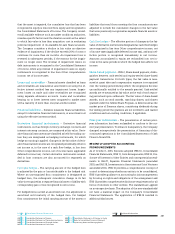Siemens 2014 Annual Report Download - page 258
Download and view the complete annual report
Please find page 258 of the 2014 Siemens annual report below. You can navigate through the pages in the report by either clicking on the pages listed below, or by using the keyword search tool below to find specific information within the annual report.
108 A. To our Shareholders 131 B. Corporate Governance 171 C. Combined Management Report
allocated to this cash-generating unit or this group of cash-
generating units is recognized. The recoverable amount is the
higher of the cash-generating unit’s or the group of cash-
generating units’ fair value less costs to sell and its value in
use. If either of these amounts exceeds the carrying amount,
it is not always necessary to determine both amounts. These
values are generally determined based on discounted cash flow
calculations. Impairment losses on goodwill are not reversed
in future periods if the recoverable amount exceeds the carry-
ing amount of the cash-generating unit or the group of cash-
generating units to which the goodwill is allocated.
Other intangible assets – The Company amortizes intangible
assets with finite useful lives on a straight-line basis over their
respective estimated useful lives. Estimated useful lives for
patents, licenses and other similar rights generally range from
three to five years, except for intangible assets with finite use-
ful lives acquired in business combinations. Intangible assets
acquired in business combinations primarily consist of cus-
tomer relationships and technology. Useful lives in specific
acquisitions ranged from eleven to twenty years for cus tomer
relationships and from three to years for technology. Intan-
gible assets which are determined to have indefinite useful
lives as well as intangible assets not yet available for use are
not amortized, but instead tested for impairment at least
annually.
Property, plant and equipment – Property, plant and equip-
ment, including investment property, is valued at cost less
accumulated depreciation and impairment losses.
If the costs of certain components of an item of property, plant
and equipment are significant in relation to the total cost of the
item, they are accounted for and depreciated separately. Depre-
ciation expense is recognized using the straight-line method.
Residual values and useful lives are reviewed annually and, if
expectations differ from previous estimates, adjusted accord-
ingly. Costs of construction of qualifying assets, i.e. assets that
require a substantial period of time to be ready for its intended
use, include capitalized interest, which is amortized over the
estimated useful life of the related asset. The following useful
lives are assumed:
Factory and office buildings to years
Other buildings to years
Technical machinery & equipment to years
Furniture & office equipment generally years
Equipment leased to others generally to years
Impairment of property, plant and equipment and other
intangible assets
– The Company reviews property, plant and
equipment and other intangible assets for impairment when-
ever events or changes in circumstances indicate that the car-
rying amount of an asset may not be recoverable. In addition,
intangible assets with indefinite useful lives as well as intangi-
ble assets not yet available for use are subject to an annual im-
pairment test. Recoverability of assets is measured by the com-
parison of the carrying amount of the asset to the recoverable
amount, which is the higher of the asset’s value in use and its
fair value less costs to sell. If assets do not generate cash in-
flows that are largely independent of those from other assets or
groups of assets, the impairment test is not performed at an
individual asset level, instead, it is performed at the level of the
cash-generating unit the asset belongs to. If such assets are
considered to be impaired, the impairment to be recognized is
measured by the amount by which the carrying amount of the
assets or cash-generating unit exceeds their recoverable
amount. If the fair value cannot be determined, the assets’
value in use is applied as their recoverable amount. The assets’
value in use is measured by discounting their estimated future
cash flows. If there is an indication that the reasons which
caused the impairment no longer exist, Siemens assesses the
need to reverse all or a portion of the impairment.
The Company’s property, plant and equipment and other intan-
gible assets to be disposed of are recorded at the lower of
carrying amount or fair value less costs to sell and depreciation
is ceased.
Discontinued operations and non-current assets held for
disposal – Discontinued operations are reported when a com-
ponent of an entity comprising operations and cash flows that
can be clearly distinguished, operationally and for financial
reporting purposes, from the rest of the entity is classified as
held for disposal or has been disposed of, if the component
either () represents a separate major line of business or geo-
graphical area of operations and () is part of a single co-
ordinated plan to dispose of a separate major line of business or
geographical area of operations or () is a subsidiary acquired
exclusively with a view to resale. In the Consolidated State-
ments of Income, income (loss) from discontinued operations
is reported separately from income and expenses from continu-
ing operations; prior periods are presented on a comparable
basis. In the Consolidated Statements of Cash Flow, the cash
flows from discontinued operations are presented separately
from cash flows of continuing operations; prior periods are pre-
sented on a comparable basis. The disclosures in the Notes
to the Consolidated Financial Statements outside NOTE
ACQUISITIONS, DISPOSITIONS AND DISCONTINUED OPERATIONS
that refer
to the Consolidated Statements of Income and the Consoli-
dated Statements of Cash Flow relate to continuing operations.
























